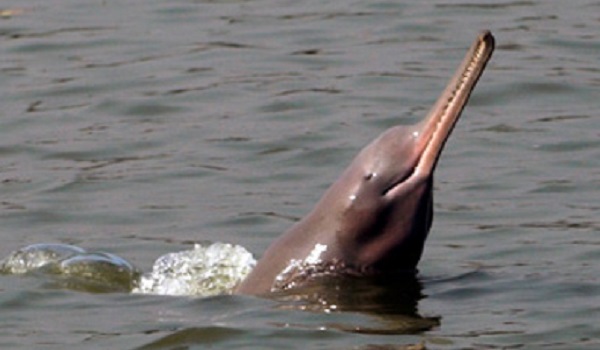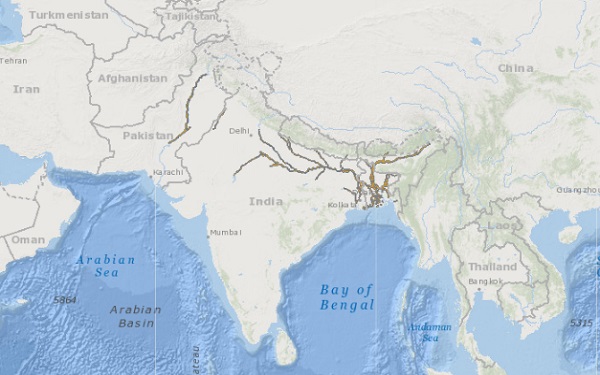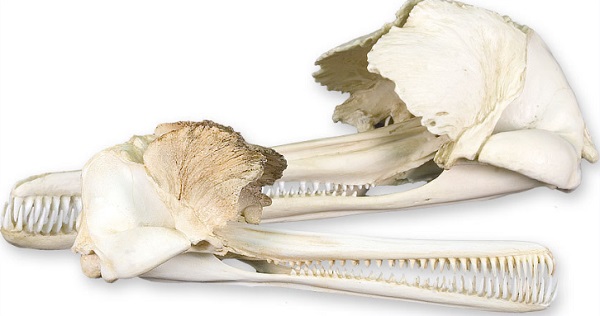
Name
- Scientific Name: Platinista gangetica.
- Common Name: South Asian River Dolphin, Blind River Dolphin, Ganges Susu (Ganges River Dolphin subspecies), Bhulan (Indus River Dolphin subspecies).
Conservation Status
- The South Asian River Dolphin is listed as Endangered by the Internation Union for the Conservation of Nature.
- It is listed under Appendix I of the Convention on International Trade of Endangered Species of WIld Fauna and Flora.
Major Threats
- Water development projects such as dams, canals, barrages and water diversion have degraded and diminished the quality and quantity of habitat fragmenting its already vulnerable population.
- Pollution in South Asia rivers have increased with industrialization. This dolphin lives in one of the most populated areas in the world. Pollutants such as mercury, salt, arsenic, fertilizers and pesticides are diluted into the river affecting the ecosystem of South Asia River dolphins and other living creatures that depend on freshwater.
- Killing river dolphins for its meat has declined in the past decades but they are still hunted by local people.
- Incidental catch and killing by gillnets as they get tangled in fishing gear. River dolphins share their habitat with other fish.

Distribution and Population
Ganges River Dolphin
- The Ganges River Dolphin (Platinista gangetica gangetica) subspecies is found in Eastern India, Nepal and Bangladesh in the Ganges-Brahmaputra-Meghna and Karnaphuli-Sangu River systems, tributaries and lakes. Its range has progressively declined since the 19th century due to pollution, industrialization and construction activities.
- Ganges River Dolphin population is extremely fragmented and is estimated at 1,200 to 1,800 according to the IUCN.
Indus River Dolphin
- The Indus River Dolphin (Planitista gangetica minor) subspecies is found in Pakistan in the lower Indus River system. Historically its distribution reached from the Indus delta to the Himalayan foothills covering about 3,400 km of the Indus River. Today its home range is 20% of its range in 1870 according to Biological Conservation , this is due to the construction of irrigation systems that have fragmented its population which no longer occurs in the Indus River Tributaries.
- The Indus River Dolphin population is extremely fragmented and is estimated at about 965 individuals according to the IUCN.

South Asia River Dolphin distribution map. Map adapted from IUCN
Habitat
Ganges River Dolphin
- The Ganges River Dolphin is a freshwater dolphin species that inhabit the muddy river waters of the Ganges, Brahmaputra, Meghna, Karnaphuli and Sangu Rivers systems, their tributaries, lakes, ponds and streams.
- They concentrate in counter current pools in channel islands, river bends and convergent tributaries.
- During monsoon floods their range expands and they migrate to other tributaries and during the dry winter season they return to the larger river channels.
- Because their population spread through a wider range they can tolerate a wide variety of temperatures from 46.4ºF to 91.4ºF (8ºC to 33ºC).
Indus River Dolphin
- They usually occur in the deepest river channel of the Indus River at depth greater than 3.3 feet (1 meter). Their preferred habitat include deep low velocity water, channel constrictions and confluences.
- It no longer occurs in the Indus River tributaries.
Physical Features
- Both subspecies of the South Asian River Dolphin are physically identical.
- They can be easily identified by their long snout, a particular characteristic of all river dolphins. The snout can reach 20% of the length of the body reaching a length of 8.3 inches (21 cm) on average. Mature females have slightly longer snouts than males. The snout becomes wider towards the tip.
- They have long sharp teeth that are visible even when their mouths are closed. As they age teeth are worn and become flat.
- Their eyes are extremely small and lack a lens making them blind. They use echolocation to navigate and hunt. Their eyes function as light detector.
- Their dorsal skin color is grey brown while their ventral skin is lighter.
- They do not have a dorsal fin, instead they have a small triangular lump.
- They have long, thin flippers and tail in relation to their body size. The flippers can be up to 18% and the tail 25% of their total body length.
- Females are larger than male.
- This species length ranges from 78.7 to 157.48 in (2 to 4 meters) and their weight from 112 to 196 lb (51 to 89 kg).
Reproduction
- Sexual maturity in males and females is reached at around 10 years old.
- Breeding occurs year round but it peaks from October to March, gestation lasts from 8 to 10 months.
- Females give birth to a single calf who depends on its mother for up to 12 months. After weaning the calf becomes independent.
Behavior
- This species has a unique feature among cetaceans in that they can swim on their sides.
- The South Asian River Dolphin is a solitary species with the exception of mother and calf. Occasionally they have been seen in congregations of 3 to 10 individuals.
- They are blind but they can detect light. They have a highly developed sonar system, also known as echolocation. Dolphins send pulse sounds or clicks which bounce back from objects in the form of echo giving them information about distance, shape, speed, material.
Diet
- These dolphins are top predators in their river ecosystems.
- They get most of their food from the bottom of the rivers and their diet includes crustaceans, fish, mollusks and aquatic plants.
Life Expectancy
- The oldest male on record lived to 28 years and the oldest female to 17.5.
Taxonomy

South Asia River Dolphin skull
- Kingdom: Animalia
- Phylum: Chordata
- Class: Mammalia
- Order: Artiodactyla
- Infraorder: Cetacea
- Family: Platanistidae
- Genus: Platanista
- Species: Platanista gangetica
Other freshwater dolphins
References and further research
- Status Assessment of the Indus \river Dolphin, Platinista gangetia minor, March-April 2001. Biological Conservation.
- The Animal aging and Longevity Database Platinista gangetia
- International Union for the Conservation of Nature – IUCN Platinista gangetica
- International Union for the Conservation of Nature – IUCN Platinista gangetica gangetica
- International Union for the Conservation of Nature – IUCN Platinista gangetica minor
- University of Michigan Museum of Zoology Platinista gangetica
- Convention on International Trade of Endangered Species of Wild Flora and Fauna
- Convention on the Conservation of Migratory Wild Species – CMS Platinista gangetica
- Food and Agriculture Organization of the United Nations – FAO Platinista gangetica
- National Oceanic and Atmospheric Organization – NOAA Platinista gangeitca minor